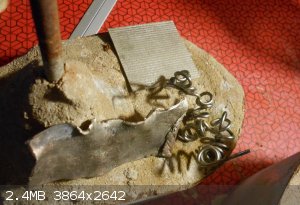BaFuxa
Hazard to Self
 
Posts: 61
Registered: 18-9-2017
Location: Mars
Member Is Offline
Mood: Buzzing
|
|
Some questions about electrochemistry
I am playing around with electrochemistry these days. I tried the anodic plating of nickel in a sodium chloride electrolyte and I got a delicious cake
of nickel hydroxide instead. I have several questions.
Nickel's reduction potential is stronger than H20 ( -0.23> -0.83V) but weaker than H+ ( 0V) and 02+ H20 (0.40 V), I still had some hydrogen gas
evolution at cathode but no oxygen bubbles was visible at the anode, the potential was > 1.23 V.
So I do not understand where the hydroxide anion is coming from.
Maybe this makes nickel oxide at the anode, much like for the lead dioxide anode making process and then this reacts with the H+ coming from the H20 4
electrons oxidation to Ni (OH)2? What do you think ? Could it be the O2 + H20 + 4 e -> 4 OH- reduction competing with nickel and turning it into
the hydroxide ?
Lastly my electrochemistry textbook says nothing about this but I am curious about the energy of the electron coming from the cathode electron "sea",
does it behave as if the cation had the power supply potential or does this electron is "delivered" with the energy of the hydrogen's electron/
cathode's outer shell ? This is of no importance in cation competition but I am still curious. How is the power supply working ? I did some research
and I could not find a clear answer to that, it starts to get into very involved physics and quantum theory that was not clear to me.
Potential counts for nothing until realized.
|
|
|
walruslover69
Hazard to Others
  
Posts: 216
Registered: 21-12-2017
Member Is Offline
Mood: No Mood
|
|
if you were just using sodium chloride as your electrolyte then you got nickel hydroxide because there was no nickel in solution. You were just
splitting water. hydrogen was evolving on the cathode and chlorine gas was evolving on the anode. you probably didn't see much gas on the anode
because the chlorine was attacking your anode creating nickel chloride or dissolving in the water. the nickel chloride then reacted with the hydroxide
formed on the cathode to precipitate nickel hydroxide.
Its also a good idea to ad a little bit of acid to lower the PH. I have read that boric acid is commonly used, but you could probably make due to any
acid if you had to.
|
|
|
happyfooddance
National Hazard
   
Posts: 530
Registered: 9-11-2017
Location: Los Angeles, Ca.
Member Is Offline
Mood: No Mood
|
|
Yeah, ditch the salt. Vinegar works fine. I have gotten better results using a nickel acetate bath than I have with either a nickel sulfate or nickel
sulfamate bath, which are both commonly used in industry. (I have also had good success with nickel oxalate, but this gives a darker luster, and is to
make a harder nickel, less cosmetically appealing).
If you start with a nickel anode and cathode, you can get nickel into solution by applying about 5 volts in vinegar (5% acetic acid) electrolyte. You
can evaporate the solution that results to recover nickel acetate, or you can use it as is. It plates onto copper well at about 1 or 1.5 volts, IIRC,
I am not sure about the current density but like any plating operation that will have to be played with. I used a brightening agent (maybe
saccharin).
Hope this helps.
|
|
|
BaFuxa
Hazard to Self
 
Posts: 61
Registered: 18-9-2017
Location: Mars
Member Is Offline
Mood: Buzzing
|
|
That is what I thought as well. Thanks! However are you sure that the Cl- anion gets oxidized ? Nickel is easier to oxidize ( Cl reduction potential
is 1.36 V while Ni's is -0.23V).
I tried with HCL and a nickel anode yesterday, the logic being that the H+ ions would neutralize the cathodic OH-s and they did  . The nickel anode corroded nicely and filled the beaker with nice nickel cations.
They plated well on lead, copper and graphite. I used about 6 V and 6 amps. On copper it appears very bright and shiny. . The nickel anode corroded nicely and filled the beaker with nice nickel cations.
They plated well on lead, copper and graphite. I used about 6 V and 6 amps. On copper it appears very bright and shiny.
Way faster method to make nickel chloride as well, for comparison I heated some nickel in the same HCL for more than a day and almost no oxidation.

[Edited on 4-7-2018 by BaFuxa]
Potential counts for nothing until realized.
|
|
|